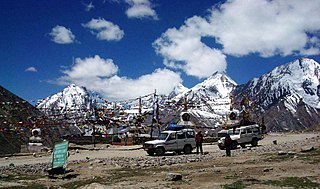| Debsa Pass | |
|---|---|
| Location | India |
| Coordinates | 31°54′15″N77°48′07″E / 31.90417°N 77.80194°E Coordinates: 31°54′15″N77°48′07″E / 31.90417°N 77.80194°E |
Debsa Pass is a 5,360-metre-high (17,590 ft) mountain pass in the Himalaya mountains between the Kullu and Spiti Districts of Himachal Pradesh, India.

A mountain pass is a navigable route through a mountain range or over a ridge. Since many of the world's mountain ranges have presented formidable barriers to travel, passes have played a key role in trade, war, and both human and animal migration throughout Earth's history. At lower elevations it may be called a hill pass. The highest vehicle-accessible pass in the world appears to be Mana Pass, located in the Himalayas on the border between India and Tibet, China.
Kullu or Kulu is the capital town of the Kullu district in the Indian state of Himachal Pradesh. It is located on the banks of the Beas River in the Kullu Valley about 10 kilometres (6.2 mi) north of the airport at Bhuntar.

Himachal Pradesh is a state in the northern part of India. Situated in the Western Himalayas, it is bordered by states of Jammu and Kashmir on the north, Punjab on the west, Haryana on the southwest, Uttarakhand on the southeast, and Tibet on the east. At its southernmost point, it also touches the state of Uttar Pradesh. The state's name was coined by acharya Diwakar Datt Sharma, one of the state's eminent Sanskrit scholars.
Joydeep Sircar led the teams that explored the watershed ridge and discovered the pass after approaching through the Parbati River valley in Kullu. After an abortive attempt on an impassable col further north in 1992, the pass was located and reached in 1993, but the team refrained from crossing it into Spiti under the mistaken impression that they could be arrested because they did not have Inner Line Permits required for Spiti. Two years later, the 1995 team planned to approach from the Spiti side, which involves much less height gain, but tremendous autumn floods in the upper valley of the Beas River and other areas of Himachal which wrecked roads forced them to take the Parbati approach again. This time they crossed the pass on 21 September and completed the route from Manikaran to Kaja.
Joydeep Sircar is a mountaineer and mountain historian. In 1979, he published his Himalayan Handbook, an index of all the-then named peaks of 6096 meters (20000 feet) and above in Afghanistan and the Indian subcontinent, giving chronological entries of expeditions up to 1975 to each peak with a brief summary of results and references to expedition reports, after a decade of solitary research. He was inspired in this formidable undertaking by the pronouncement of the late Soli S. Mehta, Hony. Local Secretary of The Himalayan Club, that the task had never been attempted before and was well-nigh impossible. This book, introduced by the famous British mountaineer-explorer J. O. M. Roberts, one of Sircar's idols, was the first one of its kind. Printed in 500 copies only, it received excellent international notices and became a basic reference resource.

The Beas River is a river in north India. The river rises in the Himalayas in central Himachal Pradesh, India, and flows for some 470 kilometres (290 mi) to the Sutlej River in the Indian state of Punjab. Its total length is 470 kilometres (290 mi) and its drainage basin is 20,303 square kilometres (7,839 sq mi) large.
Leomann's 1:200,000 map of Himachal Pradesh (Third Edition, 2005) shows a dotted track beginning at a point between the Kach (should read Kachh) and Bara Dwari Thach campsites, and crossing the Kullu-Spiti watershed divide into the West Debsa Glacier to follow the West Debsa and Debsa streams to Thidim (should be Thango) in the Parahio Valley. This is a fairly accurate representation of the 1995 route, though the pass is unmarked.
















